United States Precision Farming Software Market Size
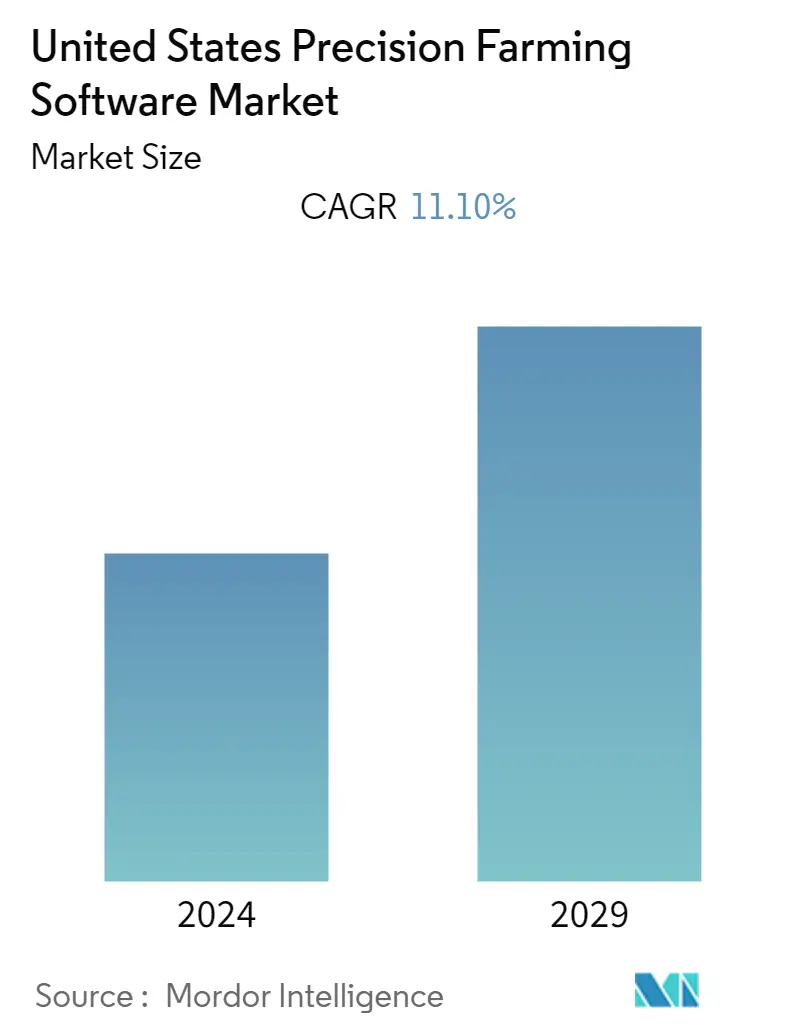
| Study Period | 2019 - 2029 |
| Base Year For Estimation | 2023 |
| Forecast Data Period | 2024 - 2029 |
| Historical Data Period | 2019 - 2022 |
| CAGR | 11.10 % |
| Market Concentration | Low |
Major Players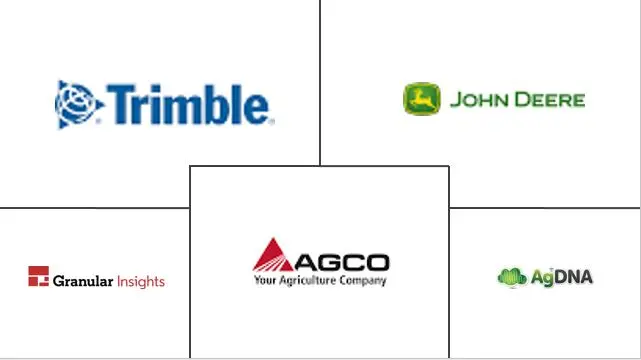
*Disclaimer: Major Players sorted in no particular order |
United States Precision Farming Software Market Analysis
The US precision farming software market (henceforth, referred to as the market studied) was valued at USD 521.9 million in 2019, and it is projected to register a CAGR of 11.1% during the period, 2020-2025 (henceforth, referred to as the forecast period). By application, the crop management segment occupied the largest market share of 31.6%, in 2019, followed by financial management, and weather tracking and forecasting. Among all the segments categorized by application, the segment for crop management is projected to witness the highest CAGR of 12.4%, over the forecast period.
United States Precision Farming Software Market Trends
Farm Labor Shortage and Rise in Average Farm Size
The United States has been witnessing an acute shortage of farm laborers. A survey by the California Farm Bureau revealed that more than 40% of the farmers have faced a consistent labor shortage, for various farm operations in the state, since the past five years, which has further led to an increased adoption rate of precision farming technologies, for ensuring better management of farm resources. According to the World Bank database, the percentage of employment in agriculture out of total employment fell drastically from 33.2% in 2010 to 28.14% in 2019. On an average, there was a decline of 22.9% in the field and crop workforce in the United States during 2002-2014, and the average age of immigrant and farmworkers rose from 37.3 years to 41.6 years and 37.4 years to 38.8 years, between 2011 and 2017, thus, signifying the need for substitution of manual laborers. The average farm size is increasing at the rate of two acres per farm since 2016, and the total number of farms declined by 13,000 to 2,029,000, in 2018. The large-holding farmers have, therefore, grown well-positioned to use precision farming software to automatically identify field surroundings and respond to variations. As per a study conducted by the Economic Research Service (ERS) in 2016, large farms were more likely to adopt precision agriculture technologies, with some of the highest adoption rates witnessed across farms of more than 3,800 acres. Till 2013, the guidance systems had the highest adoption rate in precision technology, with application in 45-50% of the area planted with corn, rice, soybean, and peanuts, followed by GPS soil mapping on 30%, and variable rate application (VRT) on 28-34% of the land. It was found that VRT increased profitability by about 1% and GPS mapping by almost 3% on cornfields in the country. Moreover, a study conducted in the mid-western state of North Dakota in the United States found that 34% farms used GPS guidance systems and 27% of the farms used autosteering systems, which saved monetized values of USD 733.85 and USD 851.27 on an average farm, in terms of time and fuel. As a result, the shortage of farm labor, accompanied with rising average farm size, is expected to drive the rate of adoption of precision farming technologies among the farmers, thereby, providing a boost to the overall precision farming software market, during the forecast period.
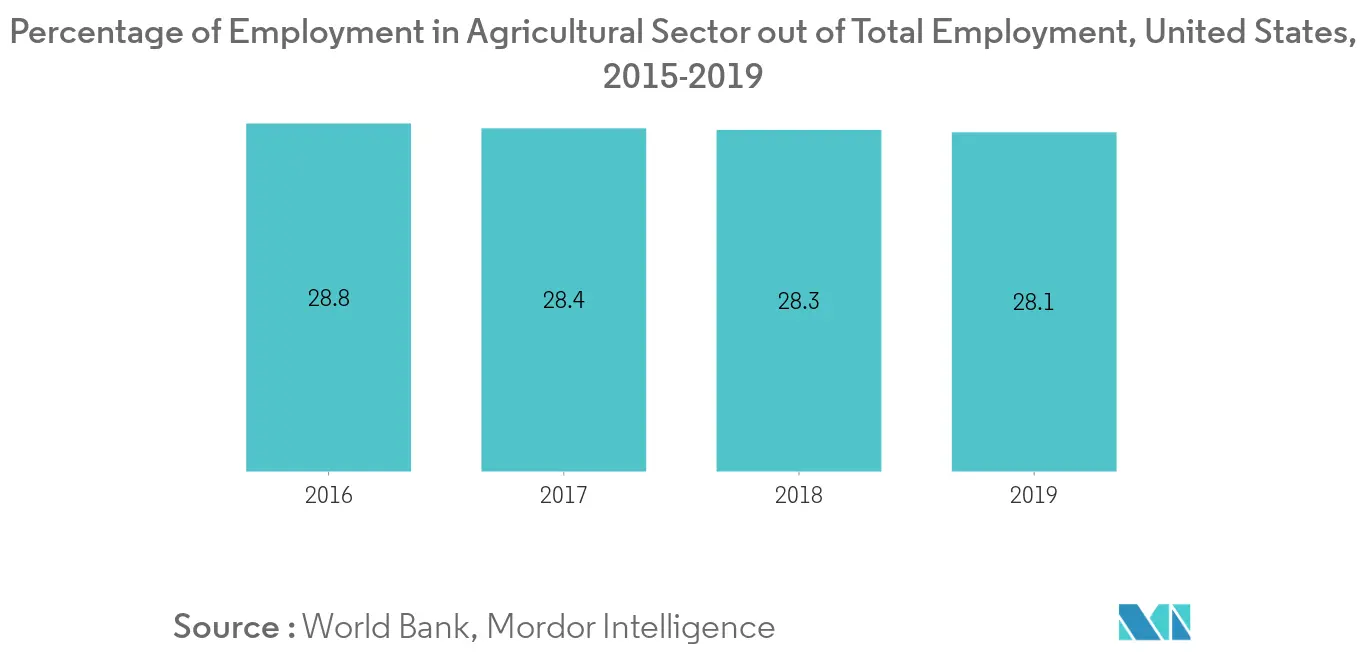
Crop Management Software Dominates the Market
The precision farming software offering its services under the crop management segment was valued at USD 164.8 million in 2019. Over the years, the US agriculture sector has undergone a transformation driven by technologies, and it seems very promising as it is enabling the primary sector to move to the next level of farm productivity and profitability. In October 2016, the United States Department of Agriculture reported that precision agriculture technologies reported increased net returns and operating profits. For instance, GPS mapping had shown the largest impact on precision agriculture technologies, with an increase in the operating profitability of almost 3% on corn farms. Similarly, the impact of mapping on net returns is almost 2%. Moreover, guidance systems raised operating profits by 2.5% and net returns by 1.5%, respectively. Thus, the increasing profitability and net returns from the precision agriculture are accelerating the adoption of precision farming technologies, thereby, promoting the adoption of precision farming software over the past few years. A study conducted by USDA, in 2017, revealed that yield mapping and global positioning system (GPS) software recorded the highest adoption for corn and soybean crops when compared to others in the US market. The study also mentioned that large farms of over 2,900 acreages has double the adoption of yield monitoring software, and the adoption rate ranging between 70% and 80%. The growing adoption trend of crop management software is primarily offset by the increasing levels of unpaid labor and higher yield goals, representing the farmers' self-reported yield potential is affecting the adoption of precision agriculture technologies in the US market. Trimble Inc., AgDNA Pty Ltd, Granular Inc., and AgJunction, among others, are few major companies indulged in offering precision farming software solutions under the crop management segment. Yield monitoring, soil mapping, crop scouting, and harvest monitoring are the popular services offered by the popular software products in the US market. Thus, the rising product innovation, coupled with the increasing focus toward profitability enhancement backed up with the rising adoption of crop management software in the large-scale farms, especially in the corn and soybean sectors, is likely to further accelerate the precision farming crop management software sales in the years to come.
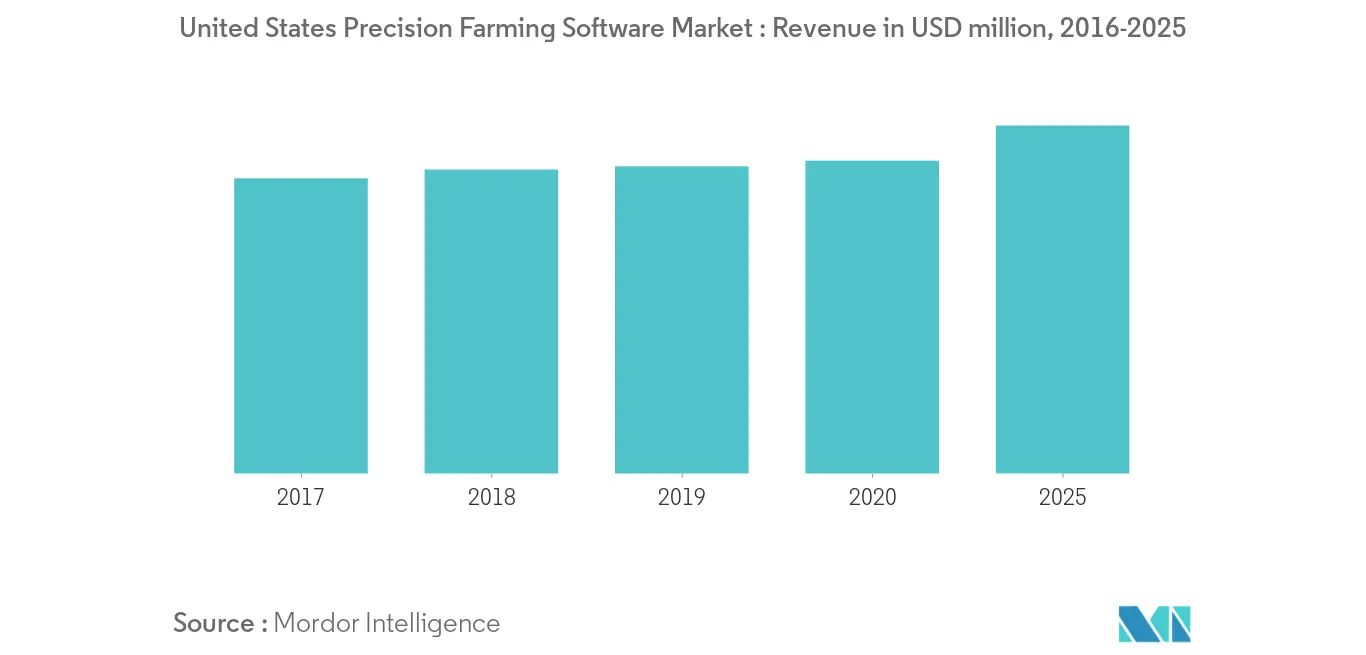
United States Precision Farming Software Industry Overview
The results of the market share analysis indicate that the precision farming software market in the United States is highly fragmented, with the top 10 players accounting for 35.8% of the overall market value. The market share of these players can be attributed to a highly diversified product portfolio. These players are also focusing on constant R&D and expanding their geographical presence. New product launches, partnerships, and expansions are the major strategies followed by these players.
United States Precision Farming Software Market Leaders
-
Granular, Inc.
-
Trimble inc
-
AgDNA
-
Deere & Company
*Disclaimer: Major Players sorted in no particular order
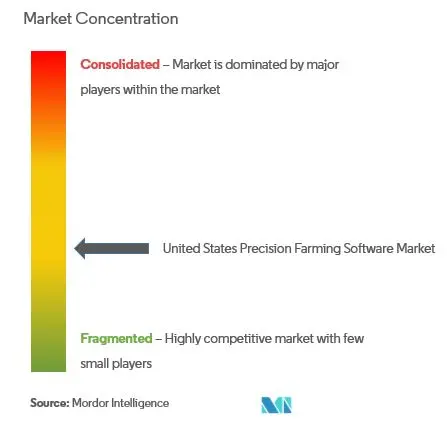
US Precision Farming Software Market Report - Table of Contents
1. INTRODUCTION
- 1.1 Study Deliverables
- 1.2 Study Assumptions
- 1.3 Scope of the Study
2. RESEARCH METHODOLOGY
3. EXECUTIVE SUMMARY
4. MARKET DYNAMICS
- 4.1 Market Overview
- 4.2 Market Drivers
- 4.3 Market Restraints
-
4.4 Porter's Five Force's Analysis
- 4.4.1 Bargaining Power of Suppliers
- 4.4.2 Bargaining Power of Buyers/Consumers
- 4.4.3 Threat of New Entrants
- 4.4.4 Threat of Substitute Products
- 4.4.5 Intensity of Competitive Rivalry
5. MARKET SEGMENTATION
-
5.1 Application
- 5.1.1 Crop Management
- 5.1.2 Financial Management
- 5.1.3 Farm Inventory Management
- 5.1.4 Personnel Management
- 5.1.5 Weather Tracking and Forecasting
- 5.1.6 Other Application Areas
-
5.2 Type
- 5.2.1 Local/ Web Based
- 5.2.2 Cloud-based
6. COMPETITIVE LANDSCAPE
- 6.1 Market Share Analysis
- 6.2 Most Adopted Strategies
-
6.3 Company Profiles
- 6.3.1 Trimble Inc.
- 6.3.2 TopCon Corporation
- 6.3.3 Granular Inc.
- 6.3.4 IBM Corporation
- 6.3.5 Deere & Company
- 6.3.6 AG DNA
- 6.3.7 AGJunction Inc.
- 6.3.8 AG Leader Technology Inc.
- 6.3.9 AGCO Corporation
- 6.3.10 Bayer CropScience AG
- *List Not Exhaustive
7. MARKET OPPORTUNITIES AND FUTURE TRENDS
** Subject To AvailablityUnited States Precision Farming Software Industry Segmentation
Precision farming software can be defined as a cloud-based tool that enables farmers to gain insights on relevant information related to factors, such as real-time data on the chosen crop and field parameters, yield monitoring, financial accounting, inventory management, and weather-related records, for maximizing farm productivity and revenues. For the study, the market has been segmented by application into crop management, financial management, farm inventory management, personnel management, weather tracking and forecasting, and other application areas. The segmentation analyzes involve detailed understating of the most prevalent areas of application of precision farming software in the United States. The scope of the report also extends to market segmentation, by type into local/web-based and cloud-based software.
| Application | Crop Management |
| Financial Management | |
| Farm Inventory Management | |
| Personnel Management | |
| Weather Tracking and Forecasting | |
| Other Application Areas | |
| Type | Local/ Web Based |
| Cloud-based |
US Precision Farming Software Market Research FAQs
What is the current United States Precision Farming Software Market size?
The United States Precision Farming Software Market is projected to register a CAGR of 11.10% during the forecast period (2024-2029)
Who are the key players in United States Precision Farming Software Market?
Granular, Inc., Trimble inc, AgDNA and Deere & Company are the major companies operating in the United States Precision Farming Software Market.
What years does this United States Precision Farming Software Market cover?
The report covers the United States Precision Farming Software Market historical market size for years: 2019, 2020, 2021, 2022 and 2023. The report also forecasts the United States Precision Farming Software Market size for years: 2024, 2025, 2026, 2027, 2028 and 2029.
United States Precision Farming Software Industry Report
Statistics for the 2024 United States Precision Farming Software market share, size and revenue growth rate, created by Mordor Intelligence™ Industry Reports. United States Precision Farming Software analysis includes a market forecast outlook to for 2024 to 2029 and historical overview. Get a sample of this industry analysis as a free report PDF download.



